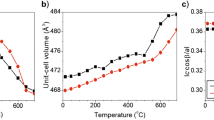Abstract
Studies of the hydrothermal behaviour of coprecipitated Al, Fe-hydroxides with aluminium contents from 5 to 50 mol% reveal that the temperature of the hydrothermal process strongly affects the reciprocal influence of Al(III) and Fe(III) ions on the direction of transformation of the initially amorphous gels.
It has been found by X-ray diffraction analysis and IR spectroscopic investigations that at 373 K, up to 10 mol% Al, well-crystallized Al-substituted hydrohematite is formed; at 15–25 mol% Al the crystallinity falls off and the products are amorphous; and at 27.5–50 mol% Al the poorly-crystallized hydrohematite appears, accompanied by different crystalline aluminium trihydroxides, the equilibria of which depend essentially on the Al∶Fe ratio and on the pH of the medium.
The hydrothermal process carried out at 413 K yields the Al-substituted protohematite for samples with 15–50 mol% Al, whereas the unique crystalline phase of Al-hydroxide is a well-crystallized boehmite.
Zusammenfassung
Untersuchungen des hydrothermalen Verhaltens von kopräzipierten Al, Fe-Hydroxiden mit Aluminiumgehalten von 5–50 mol% haben ergeben, daß die Temperatur des hydrothermalen Prozesses den gegenteiligen Effekt von Al(III)- und Fe(III)-Ionen auf die Richtung der Umwandlung der anfänglich amorphen Gele wesentlich beeinflußt. Durch Röntgendiffraktion und IR-Spektroskopie wurde ermittelt, daß bei 373 K bis zu 10 mol% Al gut kristallisierter, Al-substitutierter Hydrohämatit gebildet wird. Bei 15–25 mol% Al sind die Produkte amorph und bei 27,5–50 mol% Al liegt schlecht kristallisierter Hydrohämetit vor, begleitet von verschiedenen kristallinen Aluminiumtrihydroxiden, deren Gleichgewicht im wesentlichen vom Al/Fe-Verhältnis und vom pH des Mediums abhängt. Der bei 413 K. ausgeführte hydrothermale Prozeß ergibt Al-substituiertes Protohämatit für Proben mit 15–50 mol% A, während ein gut kristallisierter Boehmit die einzige kristalline Al-Hydroxidphase ist.
Резюме
Исследование гидрот ермического поведен ия соосажденных гидроо кисей алюминия и железа при содержани и алюминия от 5 до 50 моль ных процента показало, чт о температура гидротермического п ревращения исходных аморфных гелей в значительной мере затрагивается взаимным влиянием ио нов железа и алюминия. На основе ИК спектроскопии и ре нтгенофазового анализа найдено, что п ри 373 К и при содержании алюминия до 10 мольных процента, образуется хорошо кр исталлизующийся алюмозамещенный окс игематит. При содержа нии алюминия от 15 до 25 мольн ых процента, кристалл ичность уменьшается и продук ты образуются аморфными, тогда как п ри 27,5–50 мольных процент ах алюминия — образуетс я слабокристалличный оксигематит. Этот про цесс сопровождается обра зованием различных кристаллических гид роокисей алюминия, ра вновесие которых зависит, в осн овном, от соотношения Al∶Fe и pH сред ы. Гидротермический п роцесс, проведенный при 413 К с образцами содержащи ми 15–50 мольных процент ов алюминия, дает алюмозамещенны й протогематит, тогда к ак единственная крис таллическая фаза гидроокиси алюм иния является кристаллическим боэ митом.
Similar content being viewed by others
References
U. Schwertmann and R. M. Taylor, Iron Oxides in “Minerals in soil environments” Soil Sci. Am., Madison 1977, pp. 145–180.
E. Mendelovici and S. Yariv, Thermochim. Acta, 45 (1981) 327.
S. Caillere, L. Gatineau and S. Henin, C. R. Acad. Sci. Fr., 250 (1960) 3677.
K. Jónás, K. Solymár and J. Zöldi, J. Mol. Struct., 60 (1980) 449.
T. Tomov, D. Klissurski and I. Mitov, Phys. Stat. Sol., (a) 73 (1982) 249.
E. Wolska, Monatsch. Chem., 107 (1976) 349.
U. Schwertmann, R. W. Fitzpatrick, R. M. Taylor and D. G. Lewis, Clays Clay Miner., 27 (1979) 105.
E. Krén, B. Molnár, E. Sváb and E. Zsoldos, Solid State Commun., 15 (1974) 1707.
E. De Grave and D. Chambaere, J. Magn. Magn. Mater., 30 (1983) 349.
E. Wolska, Monatsch. Chem., 108 (1977) 819.
E. Wolska, Monatsch. Chem., 111 (1980) 889.
E. Wolska and W. Szajda, Monatsch. Chem., 111 (1980) 1329.
E. Wolska, J. Mat. Sci. Lett., 3 (1984) 817.
E. Wolska, Z. Kristallogr., 154 (1981) 69.
S. A. Fysh and P. M. Fredericks, Clays Clay Miner., 31 (1983) 377.
V. Barron, J. L. Rendon, J. Torrent and C. J. Serna, Clays Clay Miner., 32 (1984) 475.
E. Wolska and W. Szajda, J. Mater. Sci., 20 (1985) 4407.
S. Yariv and E. Mendelovici, Appl. Spectrosc., 33 (1979) 410.
E. Wolska and W. Szajda, Zh. Prikl. Spektr., 38 (1983) 160.
U. Schwertmann, Z. Anorg. All. Chem., 298 (1959) 23.
E. Wolska, Monatsch. Chem., 106 (1975) 905.
Author information
Authors and Affiliations
Rights and permissions
About this article
Cite this article
Wolska, E., Szajda, W. Temperature effects on coprecipitated Al, Fe-hydroxides during hydrothermal transformations. Journal of Thermal Analysis 32, 797–805 (1987). https://doi.org/10.1007/BF01913765
Received:
Issue Date:
DOI: https://doi.org/10.1007/BF01913765




